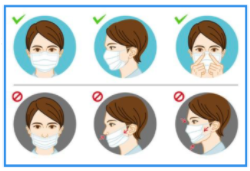
Health & Hygiene
Face Coverings

A face covering can be a covering made of cloth, fabric, or other soft or permeable material, without holes, that covers only the nose and mouth and surrounding areas of the lower face. Halloween or plastic masks, ski masks with holes for the nose or mouth, or masks that have a one-way valve designed for easier breathing (the valves are often a raised plastic disk about the size of a quarter, on the front or side of the mask) are NOT considered an acceptable face covering.
Proper Face Covering Etiquette
Wear your cloth or disposable face covering properly to help model the behavior to your child. Face covering must be worn over the nose and mouth, while avoiding touching the face covering during wearing. A face covering can be removed for meals, snacks or when it needs to be replaced. When a face covering is temporarily removed, it is to be placed in a sealable plastic container or bag provided by parents, marked with the student’s name.
Wearing Face Coverings Correctly
- Wash your hands before putting on your face covering;
- Put it over your nose and mouth and secure it under your chin;
- Try to fit it snugly against the sides of your face;
- Make sure you can breathe easily; and
- Avoid touching the face-covering while it is on. If you do need to touch or adjust the face covering, wash your hands right away.
Removing Face Coverings Correctly
- Untie the strings behind your head or stretch the ear loops;
- Handle only by the ear loops or ties;
- Fold outside corners together;
- Be careful not to touch your eyes, nose, and mouth when removing. Wash hands immediately after removing; and
- Place covering in the washing machine.
Face Shields and Clear Masks
Face shields are available for teachers and staff to use with their students. Instructional staff will be provided a Humanity Shield and a Clear Mask which are appropriate for all-day use so students can see their teacher’s face. Per Cal/OSHA, considerations for face shields should include a cloth drape attached across the bottom.
Supplies Provided
- gloves
- masks (cloth and disposable)
- face shields
- humanity shields
- hand sanitizer
- sanitizing wipes
- thermometers
- mulitfold towels
- alcohol wipes
HANDWASHING / SANITIZER
Five steps to proper handwashing
- Wet your hands with clean, running water (warm or cold), turn off the tap, and apply soap.
- Lather your hands by rubbing them together with the soap. Lather the backs of your hands, between your fingers, and under your nails.
- Scrub your hands for at least 20 seconds. Need a timer? Hum the “Happy Birthday” song from beginning to end twice.
- Rinse your hands well under clean, running water.
- Dry your hands using a clean towel or air dry them.
Staff and students should wash their hands as soon as they arrive in the classroom. Most classrooms have a sink with soap available, but the restroom can be used as well. All classrooms have a touchless hand sanitizer station.
The CDC suggests hand washing at the following times:
- Before, during, and after preparing food
- Before and after eating food
- Before and after caring for someone at home who is sick with vomiting or diarrhea
- Before and after treating a cut or wound
- After using the toilet
- After changing diapers or cleaning up a student who has used the toilet
- After blowing your nose, coughing, or sneezing
- After touching an animal, animal feed, or animal waste
- After handling pet food or pet treats
- After touching garbage
How to Use Hand Sanitizer (when hand washing is not practicable)
- Apply the hand sanitizer to the palm of one hand (read the label to confirm the correct amount).
- Rub your hands together.
- Rub the sanitizer over all the surfaces of your hands and fingers until your hands are dry. This should take around 20 seconds.
Cough & Sneeze Etiquette
It is important to add these preventative measures to reduce the spread of COVID-19 and other illnesses to students’ daily routine.
- Cough and sneeze into a tissue or into the crook of the elbow, throw the tissue into the trash right away and wash hands.
- Avoid touching the eyes, nose, and mouth with unwashed hands.
- Avoid close contact with anyone who is sick.
- Maintain a distance of 6 feet from others outside your home. Keeping distance from others is especially important for individuals at higher risk for severe illness.
- Encourage your student to ask questions and express their feelings with you and their teachers. Remember that your student may have different reactions to stress; be patient and understanding.
Student Access to Drinking Water
All drinking fountains are closed at this time in order to reduce virus transmission. Students should bring their own filled water bottles to school each day. Water bottle fill stations have been installed at each campus.
- Air Quality in Classrooms
- Board Meeting Agendas (opens in new window)
- Board Meeting Calendar
- Celebrating Students
- Cleaning, Sanitizing, & Disinfecting
- Community Resources
- Creating Safe Schools
- Development Impact Committee
- District Boundaries Map (opens in new window)
- Emergency Preparedness
- Enrollment/Online Registration
- Health & Hygiene
- Health & Safety
- LCFF / LCAP
- Parent Portal (opens in new window)
- ParentSquare: District and School Communications
- Policies, Forms & Applications
- Positive COVID Cases
- Safety Instructional Videos
- School Meals Program
- Student Calendar
- Transportation & Bus Pass
- Transitional Kindergarten
This site provides information using PDF, visit this link to download the Adobe Acrobat Reader DC software.
